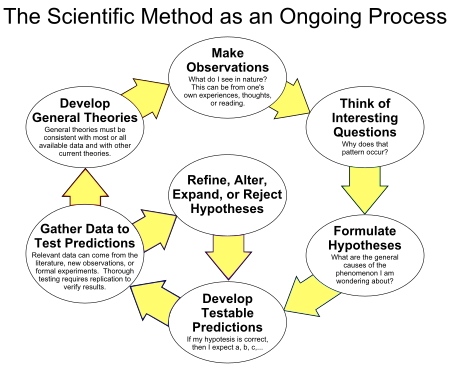Observation

The Scientific Method: from Wikipedia
The scientific method is a body of techniques for investigating phenomena, acquiring new knowledge, or correcting and integrating previous knowledge.[2] To be termed scientific, a method of inquiry is commonly based on empirical or measurable evidence subject to specific principles of reasoning.[3] The Oxford Dictionaries Online defines the scientific method as "a method or procedure that has characterized natural science since the 17th century, consisting in systematic observation, measurement, and experiment, and the formulation, testing, and modification of hypotheses".[4]Experiments are a procedure designed to test hypotheses. Experiments are an important tool of the scientific method.[5][6]
The method is a continuous process that begins with observations about the natural world. People are naturally inquisitive, so they often come up with questions about things they see or hear, and they often develop ideas or hypotheses about why things are the way they are. The best hypotheses lead to predictions that can be tested in various ways. The strongest tests of hypotheses come from carefully controlled experiments that gather empirical data. Depending on how well additional tests match the predictions, the original hypothesis may require refinement, alteration, expansion or even rejection. If a particular hypothesis becomes very well supported, a general theory may be developed.[1]
Although procedures vary from one field of inquiry to another, they are frequently the same from one to another. The process of the scientific method involves making conjectures (hypotheses), deriving predictions from them as logical consequences, and then carrying out experiments or empirical observations based on those predictions.[7][8] A hypothesis is a conjecture, based on knowledge obtained while seeking answers to the question. The hypothesis might be very specific, or it might be broad. Scientists then test hypotheses by conducting experiments or studies. A scientific hypothesis must be falsifiable, implying that it is possible to identify a possible outcome of an experiment or observation that conflicts with predictions deduced from the hypothesis; otherwise, the hypothesis cannot be meaningfully tested.[9]
The purpose of an experiment is to determine whether observations agree with or conflict with the predictions derived from a hypothesis.[10] Experiments can take place anywhere from a college lab to CERN's Large Hadron Collider. There are difficulties in a formulaic statement of method, however. Though the scientific method is often presented as a fixed sequence of steps, it represents rather a set of general principles.[11] Not all steps take place in every scientific inquiry (nor to the same degree), and they are not always in the same order.[12][13] Some philosophers and scientists have argued that there is no scientific method; they include physicist Lee Smolin[14] and philosopher Paul Feyerabend (in his Against Method). Robert Nola and Howard Sankey remark that "For some, the whole idea of a theory of scientific method is yester-year's debate, the continuation of which can be summed up as yet more of the proverbial deceased equine castigation. We beg to differ."[15]


 Follow
Follow

